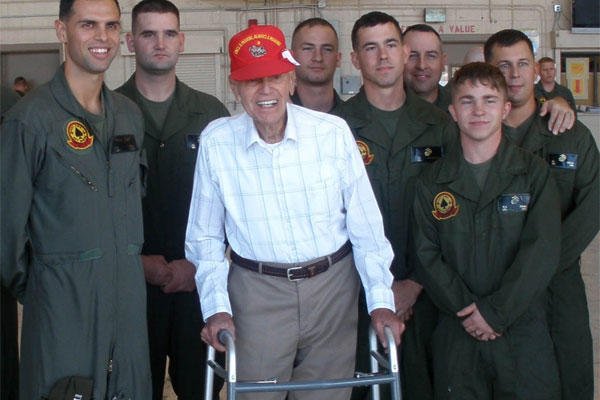MARINE CORPS BASE CAMP PENDLETON, Calif. – “Putt! Putt! Putt! Putt!”
Imitating the sound of a Curtiss Condor’s engines failing, Frank Baron Jr. mimics the tumbling motions of the aircraft falling from the sky. His hands rush to his shoulders as if grabbing for parachute straps.
“I thought, ‘This is it,’ and then all of a sudden, brrrr!” he said, describing the sound of the engines returning to life as he sinks into the back of the couch, grinning, but sighing with relief.
“That’s the most scared I ever was, and I love to fly,” said Baron, 98, who’d served as an airplane rigger during a crucial period in the evolution of Marine aviation.
Baron’s love for the Marine Corps was sparked in Glen Burnie, Md., where he was born April 18, 1914.
“I liked the Marines, I’d known them from the time I was just a kid,” Baron explained. He grew up three blocks from a training area used by a Marine unit.
There was no grass, only leaves from the shade trees, Baron said of the training grounds. He said would often visit and ask the Marines if they wanted anything from the commissary.
“‘Yeah, get me a pack of cigarettes,’ or ‘Get me some soda pop,’ or this or that,” he said in a forced, gruff voice, pulling his eyebrows together. “I’d get it, and they’d give me a nickel or a dime.”
These experiences inspired his trip to Parris Island, S.C., in 1933, which marked the beginning of his four-year enlistment as a military police officer in the Marine Corps.
Baron’s first assignment was to the Haitian capital Port-au-Prince, where he and his friends, after standing guard at the Presidential Palace, would go to Gonaives Bay and dive from a five-story-tall platform.
“We would climb up, and dive off like swans,” Baron chuckled at the memory. “We would be up there looking down, and about a block from us there were sharks.”
After nine months in Haiti, Baron was briefly brought back to Parris Island before being sent to San Diego in California.
When he arrived in San Diego, then-Pvt. Baron saw the military pilots flying and immediately requested a transfer, he said.
“I’ve always enjoyed being around planes,” Baron said, his eyes lighting up with excitement. “When I was a kid, planes used to fly over, and we would wave. You’d never believe it, but they would wave back!”
In 1935, Baron was transferred to North Coronado Island, officially recognized by the House Armed Services Committee as the birthplace of Marine Corps Aviation.
“I was working in the wings section. We would pull the canvas over the wings and goop it up with sealant,” Baron said as he made pulling and stretching motions with his hands, simulating the repairs.
Every day after work, Baron said he would look for space-availability flights. For the next two years, he would board planes for the pure joy of flying.
The flights would go almost anywhere; from out over the ocean to down to the border of Mexico, he said.
After his enlistment ended, Baron joined the San Diego fire department, and once his two granddaughters were born, he said he knew he wanted to share his passion with them.
“When my sister and I were young, he would take us to the San Diego airport to watch the planes land and take off,” said Teri Juybari, one of Baron’s granddaughters. “We would watch for what seemed like hours, and as little kids, that was pretty exciting.”
This year, Marine Corps aviation is celebrating its centennial, which was made possible through the efforts and dedication of Marines like Baron.
The time he spent in the Marines and working on the planes he loved made such an impact on his life, Juybari said. After 75 years, Baron is still proud of being a Marine.


























